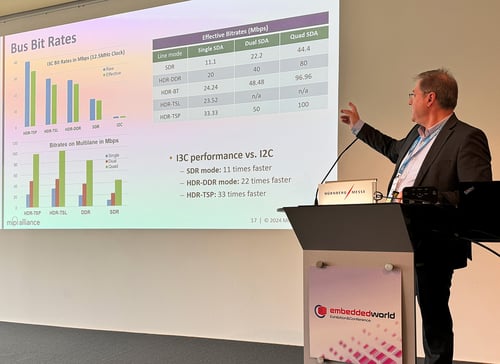MIPI DigRF™
Chip-to-Chip/IPC
.jpg?width=1800&height=900&name=Banner%20Images%20-%20MIPI%20(1).jpg)
Developed by: DigRF (HIBERNATED WORKING GROUP)
A high-speed interface connecting the RFIC to the baseband processor
Quick Facts
-
Fundamental Features
- High performance
- Low power
- Low EMI
-
Physical Layer
M-PHY
-
Use Cases
- Connecting radio frequency transceivers in mobile devices to baseband modem
- EMI-sensitive high data rate applications
- Highly reliable links with error protection
- Real-time interfaces with low latency and fast start-up time
- Interfaces with packet-oriented traffic bursts
- Transferring sample data with adjustable word length
- Combined control and data traffic with flexible protocol adjustment
Get the Specification
-
Current Version
MIPI DigRF℠ v4 v1.2 (February 2014)
Member version
-
Previous Versions
All DigRF versions are available to MIPI members on the member website (Causeway).
Overview
General Info
-
Overview
MIPI DigRFSM is a high-speed interface that is used to interconnect the RFIC in a device with the baseband processor. It is designed to provide a convenient approach for integrating components and meeting the data-intensive needs of 4G LTE air interfaces that require high channel bandwidth.
-
Implementation
It is a low-complexity solution for complex implementations that typically require multi-mode, multi-band operation. It natively handles MIMO configurations, receive diversity and carrier aggregation. In addition to LTE, it supports HSPA+, 3.5G and 2.5G air interfaces.
-
Performance Highlights
MIPI DigRF is a high-level interface that operates on the MIPI M-PHY physical layer, enabling a single link between the baseband and RFIC. MIPI DigRF focuses on the protocol and programming used to interface the components, enabling vendors to differentiate their overlying system designs while providing interoperability at the interface level between compliant ICs.
The interface is flexible and scalable, allowing use of multiple receivers and transmitters simultaneously. At the same time, it helps minimize pin count and overall interface power consumption, and manages electromagnetic interference (EMI).
-
Latest Release
MIPI DigRF is developed by the MIPI DigRF Working Group. The most recent version of the MIPI DigRF specification, v4 v1.2, was released in 2014.
Note: The specification is available only to MIPI Alliance members. For information about joining MIPI Alliance, visit Join MIPI.






